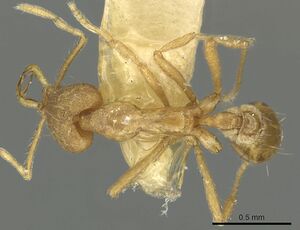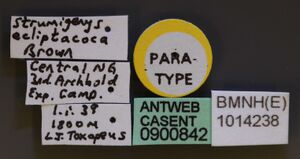Strumigenys ecliptacoca
| Strumigenys ecliptacoca | |
|---|---|

| |
| Scientific classification | |
| Kingdom: | Animalia |
| Phylum: | Arthropoda |
| Class: | Insecta |
| Order: | Hymenoptera |
| Family: | Formicidae |
| Subfamily: | Myrmicinae |
| Tribe: | Attini |
| Genus: | Strumigenys |
| Species: | S. ecliptacoca |
| Binomial name | |
| Strumigenys ecliptacoca Brown, 1958 | |
Nothing is known about the biology of Strumigenys ecliptacoca.
Identification
Bolton (2000) – A member of the feae complex in the Strumigenys mayri-group. See Strumigenys leptorhina.
Keys including this Species
Distribution
Distribution based on Regional Taxon Lists
Indo-Australian Region: Indonesia, New Guinea (type locality).
Distribution based on AntMaps
Distribution based on AntWeb specimens
Check data from AntWeb
Countries Occupied
| Number of countries occupied by this species based on AntWiki Regional Taxon Lists. In general, fewer countries occupied indicates a narrower range, while more countries indicates a more widespread species. |

|
Estimated Abundance
| Relative abundance based on number of AntMaps records per species (this species within the purple bar). Fewer records (to the left) indicates a less abundant/encountered species while more records (to the right) indicates more abundant/encountered species. |

|
Biology
|
Castes
Worker
Images from AntWeb
   
| |
| Paratype of Strumigenys ecliptacoca. Worker. Specimen code casent0900842. Photographer Ryan Perry, uploaded by California Academy of Sciences. | Owned by NHMUK, London, UK. |
Nomenclature
The following information is derived from Barry Bolton's Online Catalogue of the Ants of the World.
- ecliptacoca. Strumigenys ecliptacoca Brown, 1958i: 111 (w.q.) NEW GUINEA. See also: Bolton, 2000: 880.
Unless otherwise noted the text for the remainder of this section is reported from the publication that includes the original description.
Description
Worker
Bolton (2000) - TL 2.5-2.6, HL 0.66-0.70, HW 0.42-0.45, CI 64-65, ML 0.33-0.36, MI 50-51, SL 0.46-0.48, SI 102-107, PW 0.24-0.28, AL 0.67-0.74 (3 measured).
Characters of the feae-complex. Preapical tooth spiniform and feebly curved, its length about twice the maximum width of the mandible. Outer margin of mandible in full-face view extremely shallowly convex from close to base to level of preapical tooth. Upper scrobe margin with two freely laterally projecting simple, non-flagellate hairs, the posterior in the apicoscrobal position. Cephalic dorsum with 4-6 erect stiff simple hairs along the occipital margin, a similar pair present at highest point of vertex. Ventrolateral margin of head may have a short shallow concavity immediately in front of eye but there is no well defined preocular notch. Maximum diameter of eye distinctly greater than maximum width of scape. Scrobe shallow and poorly defined behind level of eye. Pronotal humeral hair stiff and simple, not flagellate. Dorsal alitrunk without standing hairs except for a short mesonotal pair. Dorsal surfaces of waist segments and first gastral tergite with simple hairs. Pleurae and side of propodeum smooth; dorsal alitrunk with pronotum and propodeum mostly to entirely smooth, mesonotum feebly punctate. Propodeum without teeth, the angle between dorsum and declivity with only a pair of minute triangular tubercles; declivity without a lamella. Dorsal (outer) surfaces of hind basitarsus and hind tibia without erect long hairs of any form; dorsum of hind femur without erect long hairs. Petiole in profile subclavate, anterior face of node only slightly more strongly inclined than peduncle and rounding broadly into the dorsum. Lateral spongiform lobe of petiole low on side posteriorly, small and rounded; node without a posterior spongiform transverse collar. Disc of postpetiole smooth and shining. Basigastral costulae subequal to length of postpetiole.
Queen
Brown (1958) - Paratypes, 2 dealates from type nest: WE, 3.3-3.3, HE 0.73-0.74, ME 0.36-0.36, WL 0.85-0.86; CI 68-67, MI 49-49, respectively. Showing the usual caste differences or he genus. Propodeal teeth low, subtriangular, but definitely dentiform. Mesonotum evenly punctulate, with a few fine erect hairs. Infradental lamellae present as fine lines or low carinae. Side sclerites of alitrunk largely smooth and shining, as is propodeal declivity; dorsum of alitrunk completely punctulate. Basal gastric costulae relatively stronger and longer than in worker. Color slightly darker and more brownish.
Type Material
Bolton (2000) - Holotype worker, paratype workers and queens, INDONESIA: Irian Jaya, Camp 1., i.1939, Netherlands Indies-American New Guinea Expedition (Third Archbold Expedition) 1938-39, 1800 m. (J. L. Toxopeus) (BZB, Museum of Comparative Zoology, California Academy of Sciences) [examined].
References
- Bolton, B. 2000. The ant tribe Dacetini. Memoirs of the American Entomological Institute. 65:1-1028. (page 880, redescription of worker)
- Brown, W. L., Jr. 1958i [1957]. The Indo-Australian species of the ant genus Strumigenys Fr. Smith S. decollata Mann and S. ecliptacoca new species. Psyche. 64:109-114. (page 111, worker, queen described)
References based on Global Ant Biodiversity Informatics
- Brown W. L., Jr. 1958. The Indo-Australian species of the ant genus Strumigenys Fr. Smith: S. decollata Mann and S. ecliptacoca new species. Psyche (Camb.) 64: 109-114.
- Janda M., G. D. Alpert, M. L. Borowiec, E. P. Economo, P. Klimes, E. Sarnat, and S. O. Shattuck. 2011. Cheklist of ants described and recorded from New Guinea and associated islands. Available on http://www.newguineants.org/. Accessed on 24th Feb. 2011.

